
What’s weighing on consumer spending: Fear of COVID-19 and its economic impact Economics Spotlight, August 2020
7 minute read
28 August 2020
Consumer spending in the United States has taken a hit recently. Spending has been affected as consumers worry about contracting COVID-19 and their household finances due to the economic downturn.
Consumer spending has borne the brunt of COVID-19’s impact on the economy. Real personal consumption expenditure (PCE), which accounts for a little less than 70% of GDP, fell by 10.1% in Q2 2020 compared to Q1 2020,1 the sharpest quarterly contraction on record. This contraction in demand, in turn, pushed wider economic activity down in Q2 by the most since national accounts records started. So, what’s holding back consumers? Analysis of economic data2 and Deloitte’s State of the Consumer Tracker3 (see sidebar, “Tracking consumer behavior and decisions across 18 countries”) reveals two key factors are weighing on consumer spending in the United States. First, worries about contracting the virus are forcing people to restrict their movements, which in turn has hit spending. And second, as the economy takes a beating, rising unemployment and worries about likely job losses in the future are prompting people to hold on to their earnings and save more.
Tracking consumer behavior and decisions across 18 countries
Deloitte’s State of the Consumer Tracker aims to gauge the level of concern among consumers across 18 countries about their health and personal finances due to the pandemic and its economic impact. Through biweekly surveys, the tracker also looks at key spending decisions such as what to purchase (say, groceries, furnishing, entertainment) and how (say, online versus in-store). In this way, the tracker not only gives a quick brief about consumer decisions biweekly, but also aims to explore over time whether the pandemic brings out any shifts in consumers behavior and whether these shifts turn out to be transient or enduring. Initially, the survey was carried out in 13 countries, querying about a thousand consumers in each country. Since then, the tracker has been expanded to 18 key economies in three different regions:
- Americas: Canada, Chile, Mexico, and the United States
- Europe: Belgium, France, Germany, Ireland, Italy, Netherlands, Poland, Spain, and the United Kingdom
- Asia Pacific: Australia, China, India, Japan, and South Korea
Learn more
Learn how to combat COVID-19 with resilience
Explore the Economics collection
Learn about Deloitte’s services
Go straight to smart. Get the Deloitte Insights app
Services bear the brunt as consumers cut spending in Q2
Consumer spending on services contracted by 13.3% in Q2, much worse than the dip in spending on durable goods (-2.9%) and nondurable goods (-4.2%). The disproportionate impact on services spending is likely due to consumers cutting back on purchases that they deem nonessential, or because such purchases involve going to a venue where the risk of contracting the virus is relatively high. For example, spending on recreational services and on food services and accommodation has fallen sharply as consumers shy away from theaters, theme parks, restaurants, and bars (figure 1). Spending on transportation services also suffered in Q2 (-36.7%) as many people shifted to “work from home” and shunned shared forms of communal travel from taxis and other car services to airlines, buses, and subways as they tried to socially distance.4 While services appear to be bearing the brunt, consumers cut down on purchases of certain goods as well; spending on clothing and footwear, for example, has fallen sharply this year as figure 1 reveals.
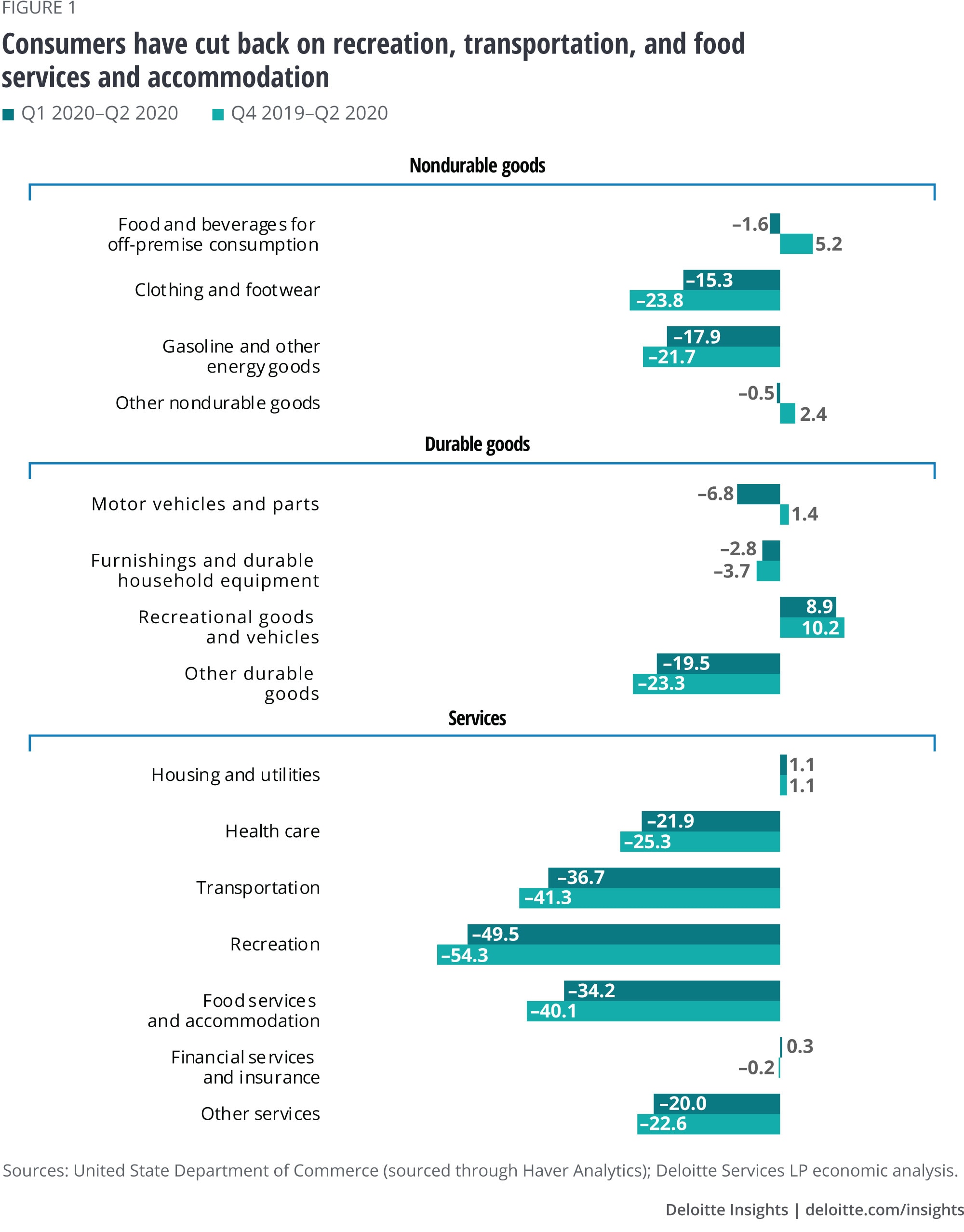
The virus is still weighing on people’s minds … and hence, spending
The pandemic has people concerned about their health and that of their friends and family. Deloitte’s State of the Consumer Tracker reveals that US consumers continue to display an elevated level of anxiety, with 33.2% of respondents in the latest survey5 (August 16) saying they were more anxious in the week of the survey compared to the prior one. Similarly, 51.7% of respondents were concerned about their physical well-being and 61.1% were worried about the health of their family members and others in their immediate circle. Figure 2 shows that after a slight decline, anxiety and health-related concerns have been inching up since mid-June. This is most likely due to the surge in virus cases in July7 (see sidebar, “The role of demographics and media in shaping consumer concerns”).
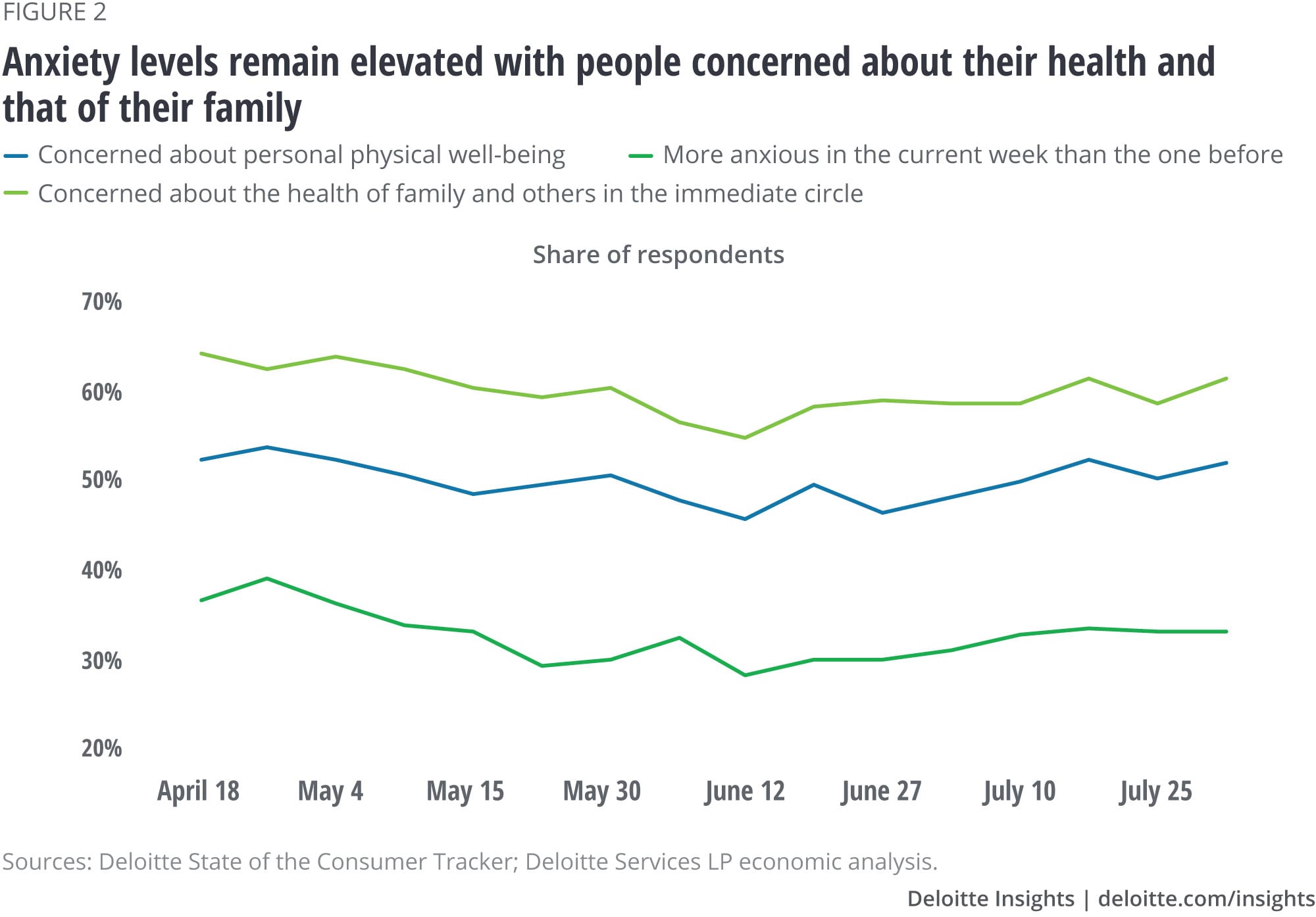
The role of demographics and media in shaping consumer concerns
In the United States, consumers’ concerns about their health and their perceptions of safety are influenced by demographic factors,8 according to analysis of the data from Deloitte’s Global Consumer Tracker. Older people, for example, seem to be more worried about their health than younger ones. This is perhaps due to the increased likelihood of older people becoming severely ill from COVID-19.9 Area of residence also plays a part—people in urban areas appear more concerned about their health than those in rural areas. And gender matters too, with females more likely to be concerned about their health than their male counterparts.
The analysis also reveals the role of the local media’s coverage of the pandemic in shaping consumer concerns. For example, the higher the fraction of news media coverage on COVID-19 in a consumer’s state of residence, the more likely it is that he or she has greater health-related concerns and perceptions of safety. It’s not only the coverage that matters in shaping concerns, but also the tone of the news media’s coverage about the pandemic.
For more on the methodology used in this analysis, refer to the appendix, “Methodology used in determining the impact of different factors on consumer concerns.”
Anxiety and health-related concerns caused people to restrict their movements, thereby impacting spending in the second quarter—and these concerns are continuing into the third quarter. In the latest survey, 21.3% of respondents said that they still do not feel comfortable going to a store for purchases, although this figure has fallen compared to April. People also appear keen to avoid places where there is likely to be physical proximity or contact with others: 46.4% of respondents do not feel safe going to a bar or restaurant and 64% do not feel safe attending in-person events such as concerts, sporting events, theaters, or theme parks. A sizeable share of consumers—32.2% of respondents in the latest survey—also seem concerned about visiting salons, doctors, or dentists, reflecting a desire to avoid engaging with one-on-one service providers.
Figure 3 shows that many remain concerned about travel. With people wary of contracting the virus, a sizeable share of respondents still wants to limit the use of public transport or ride-hailing services over the next three months. A broader shift to working from home has also affected travel trends—among those who are employed, 35.2% seem to be working from home every day (figure 3). These trends likely explain part of the sharp fall in consumer spending on services such as recreation, food services and accommodation, transportation, and health care, as shown in figure 1.
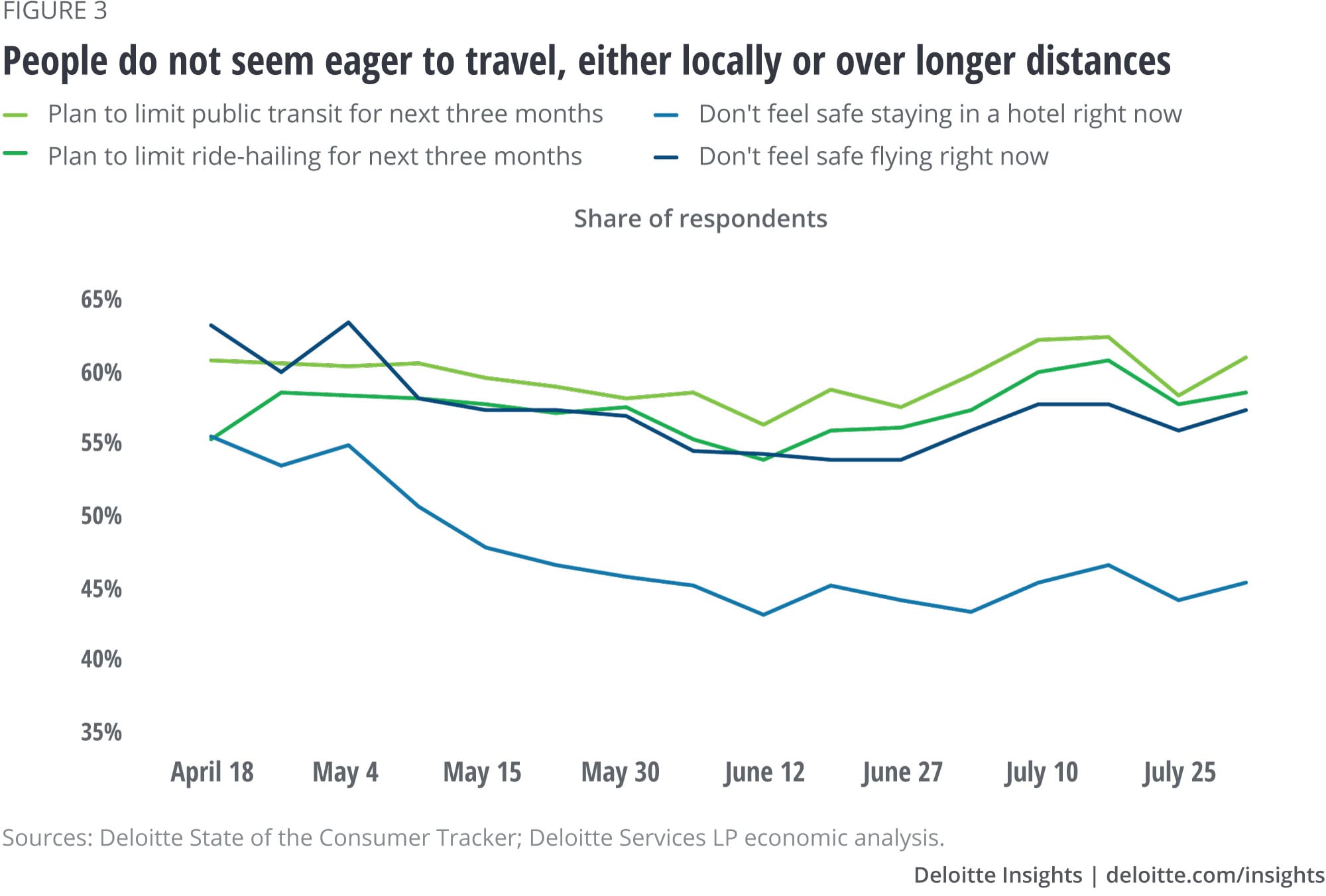
It’s not just health worries, but financial ones too that are adding to consumer woes
Adding to consumers’ spending woes are worries about jobs and personal finances due to the current recession.10 The economy contracted by 32.9% on a seasonally adjusted annual basis in the second quarter, the sharpest quarterly contraction since records are available. This, in turn, has hit the labor market. Total employment fell by 10.4% between February and June with the unemployment rate going up to 11.1% from 3.5% during this period (figure 4). This scenario is unlikely to improve swiftly given the current trajectory of the pandemic. Deloitte economists expect the economy to begin a permanent recovery only in mid-to-late 2021 (as a vaccine or treatment is deployed).11 Given such grim economic prospects, people are naturally holding on to their earnings and not spending as much as they would normally, even if they have not already lost a job. Savings have therefore surged, with the personal savings rate more than doubling to 19% in June from 8.3% in February.
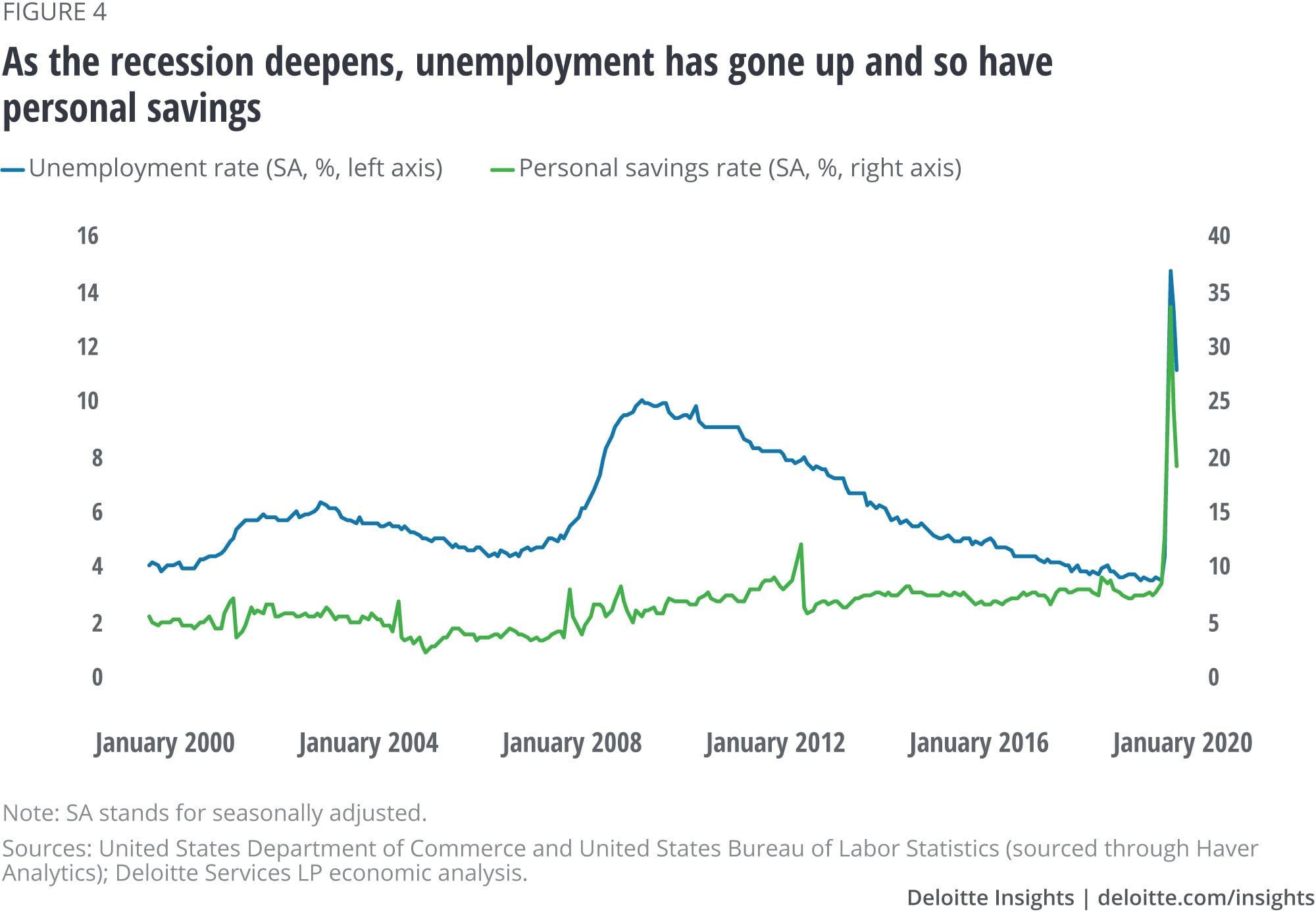
Consumers’ concerns about their jobs and incomes are also evident from the State of the Consumer Tracker. In the latest survey, 12.9% of employed respondents were either on reduced hours or on time off without pay—36.5% of those employed seem worried about their jobs. That’s not all. Figure 5 shows that many respondents have delayed large purchases they would have made otherwise, while some are wary of not being able to make upcoming payments (such as rent or mortgages). Not surprisingly, rents and mortgages are a larger concern for low-income households and those households where someone has experienced a loss of employment.12
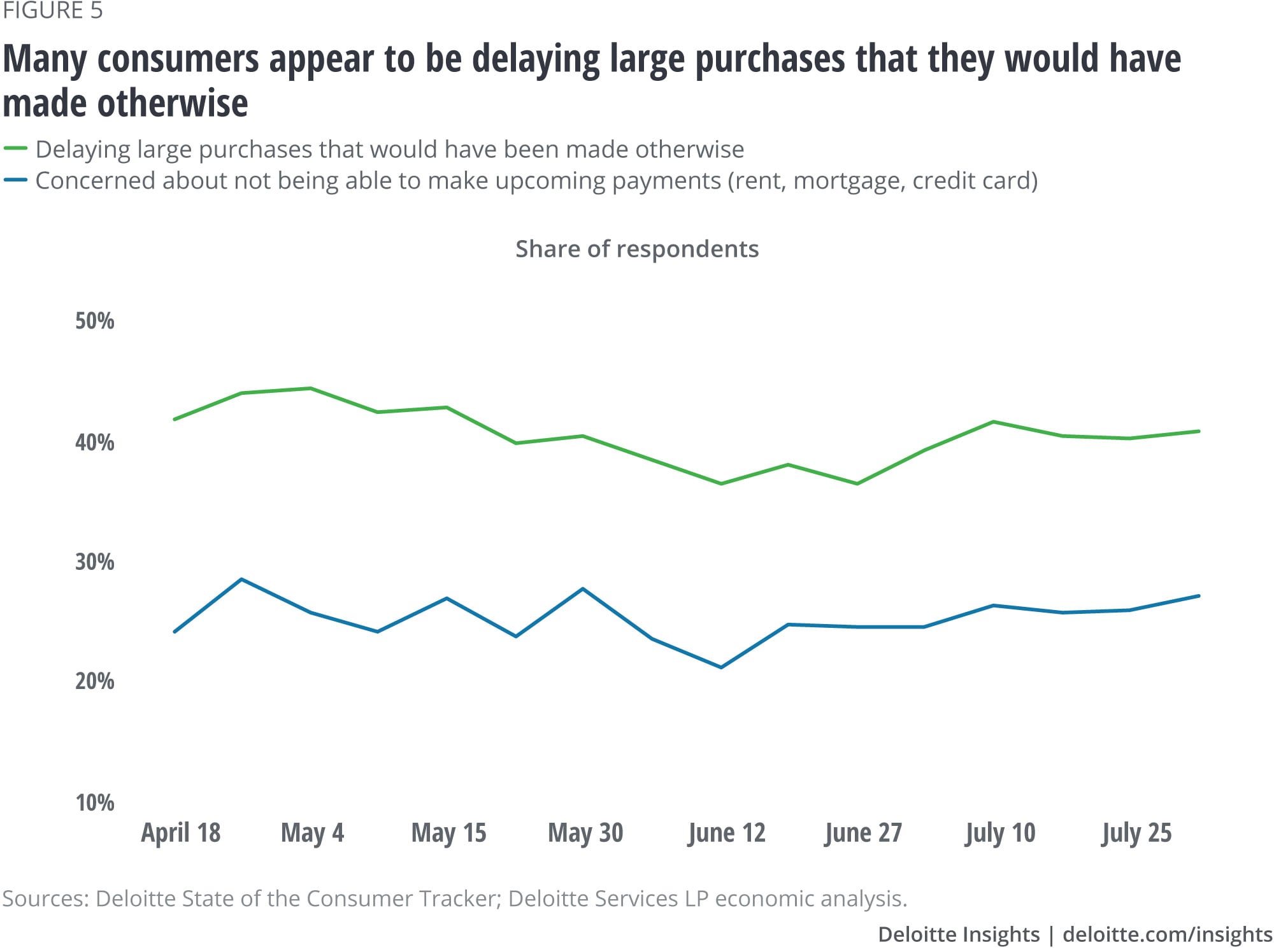
Removal of stimulus measures may hit spending more
The expiration of Federal Pandemic Unemployment Compensation (FPUC) benefits, under which people getting unemployment insurance were entitled for an extra US$ 600 per week, could prove to have a strong impact on consumer spending.13 Depending on their state of residence, beneficiaries stand to lose about 52–79% of their unemployment insurance payments under the Coronavirus Aid, Relief, and Economic Security Act.14 In the absence of any alternate aid, the expiry of FPUC would mean a sharp dent to incomes and hence, spending by those who are unemployed and at the lower end of the income ladder—the labor market impact of this recession so far is being felt more by those in low-wage occupations.15 And even if some form of new stimulus makes its way, it wouldn’t essentially remove the uncertainty regarding the pandemic itself. Daily case numbers continue to be high16 with no vaccine expected to be available for use shortly.17 In such a scenario, the recovery in consumer spending will likely be slow and staggered, just like the wider economy.18
Appendix: Methodology used in determining the impact of different factors on consumer concerns
In this analysis, multivariate models were used to determine the interaction between respondents’ demographic profiles, their concerns, and their perceptions of safety with news coverage about the pandemic, and new virus cases and death rates due to COVID-19. One of the goals of the broader research was also to find out how these concerns ultimately impact consumers’ spending expectations (say, spending plans on travel). SPSS Statistics and R were used to analyze and model the data on US consumers collected from weeks 5, 7, 9, 11, and 13 of the surveys for Deloitte’s State of the Consumer Tracker. These survey responses were matched by respondents’ state of residence to state-level metrics such as local television (ABC/CBS/FOX/NBC) and local newspaper coverage of COVID-19, and actual virus cases and deaths. Data about media coverage and tone was sourced from The Global Database of Event Location and Tone Project; COVID-19 data, including cases and deaths by state, was sourced from USA Facts.
© 2021. See Terms of Use for more information.
Explore our COVID-19 content
-
ConsumerSignals Interactive1 month ago
-
US consumer payments in a post-COVID-19 world Article4 years ago
-
How the pandemic is changing the future of automotive Article4 years ago
-
A case of acute disruption Article4 years ago














